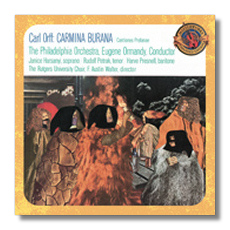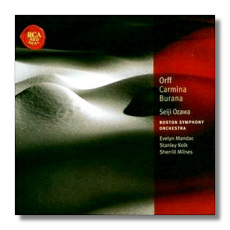
The Internet's Premier Classical Music Source
Related Links
- Orff Reviews
- Latest Reviews
- More Reviews
-
By Composer
-
Collections
DVD & Blu-ray
Books
Concert Reviews
Articles/Interviews
Software
Audio
Search Amazon
Recommended Links
Site News
 CD Review
CD Review
Carl Orff

- Carmina Burana
- Catulli Carmina (excerpts)
Janice Harsanyi, soprano
Rudolf Petrak, tenor
Harve Presnell, baritone
The Rutgers University Choir
Philadelphia Orchestra/Eugene Ormandy
Sony Classical Legacy SK93081
Carmina Burana only also available on single-layer SACD
Amazon
- UK
- Germany
- Canada
- France
- Japan


Carmina Burana
Evelyn Mandac, soprano
Stanley Kolk, tenor
Sherrill Milnes, baritone
New England Conservatory/Lorna Cooke de Varon
Children's Chorus of the New England Conservatory/Katherine Edmonds Pusztai
Boston Symphony Orchestra/Seiji Ozawa
RCA Red Seal 59417
I never cease to be amazed about so much of life. Sometimes I feel like I like an accidental tourist visiting this planet, a stranger in a strange land. Mostly I feel like a kid discovering something. One of the amazing things is how very different the same music can sound. Take, for example, Carmina Burana. These two 'new' releases and a third, by Stokowski, make you realize that the music is really never the same. Music is more than black marks on white paper.
The Ormandy recording has been accorded highest praise from several sources. The Penguin Guide to Compact Discs (which grants the recording a rosette) comments, "… there is no finer analogue version. It has tremendous vigour, warmth and colour and a genial, spontaneous enthusiasm." Well, I would agree with warmth and genial, but this is not the finest analogue version I know. That would be the Ozawa or even the Stokowski version perhaps. Whilst the Ormandy recording is much better transferred than the other two, the sound has a warmth and perspective that is wonderful, it is too genial. To be blunt, it is earth-bound to the point of being close to boring.
Let me take two points as an example. First is the famous (or infamous thanks to being used in movies and commercials) opening, O' Fortuna. Where the hell are the timpani in the Philadelphia Orchestra? In Ozawa's recording it is very prominent, bringing the close to an exciting climax in every sense of that word. Ozawa takes about ten seconds less than Ormandy but it is not just the timing, it is also the incisiveness of the performance. The soloists in the Ormandy recording are good, but there is no bite to their singing. Ozawa's chorus is crisp, articulate and keeps me on the edge of my chair. Then let me take you to track #8, Chramer, gip die varwe mir. Ormandy's chorus is good but, again, this doesn't sound like a young woman. The Boston Symphony Orchestra performance of this part has a sweet, childlike feel to it. It is involving. The chorus swings gently to-and-fro.
Now, I also listened to the Stokowski recording with the Houston Symphony. The first thing that caught my attention is that the chorus is much closer in the recording. The orchestra is not distant but is behind the singers. The opposite is true of the other two.
At the end of all this listening I decided to get a second opinion. My dog, Carl, had been sitting on the floor as I played these recordings. I asked him which he liked best and to signify: one bark is for Ormandy, two for Ozawa or three for Stokowski. He immediately barked, "Orf… Orf!" Then looked at me, bowed his head and added, "Orf."
The Ormandy recording does not include the text.
Copyright © 2004, Robert Stumpf II



















